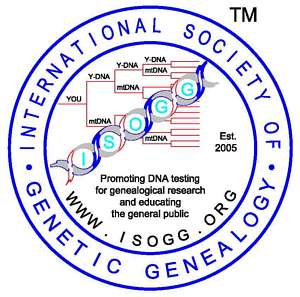Back to Y-DNA Tree Trunk
Back to SNP Index
Back to Papers Cited
Back to Glossary Back to Listing Criteria
Copyright 2007, International Society of Genetic Genealogy. All Rights Reserved.

| LINKS: Main Page Y-DNA Tree Trunk SNP Index Papers Cited Glossary Listing Criteria |
| CLADE/SUBCLADE SYMBOLS: Added Renamed |
| SNP SYMBOLS: Not on 2006 tree Confirmed within subclade Provisional Private |
P 92R7, M45, M74/N12, P27, S25
�
P* -
�
Q
M242, MEH2, P36
�
R
M207/UTY2, M305/S1, S4, S8, S9
NOTES:
Y-DNA haplogroup P, an offshoot of Haplogroup K, originated in Central Asia some 35,000 years ago; sites in Uzbekistan, Kazakhstan and southern Siberia have been offered as the likely point of first appearance. Haplogroup P is best represented by its two immediate subclades, haplogroups Q and R, which expanded to become the dominant haplogroups in, respectively, the Americas and Europe. Undifferentiated Haplogroup P exists in widely scattered locations near the Black Sea (Ossetia), in the Near East (Kurdish Turkey), Central to Eastern Asia (Southern Siberia and Mongolia) and South America (Northeastern Brazil).
References:Behar et al,
Contrasting Patterns of Y Chromosome Variation in Ashkenazi Jewish and Host
Non-Jewish European Populations. (pdf) Hum Genet 114:354-365, 2004.
Bortolini et al,
Y-Chromosome Evidence for Differing Ancient Demographic Histories in the Americas.
American Journal of Human Genetics, 73:524�539, (2003).
Capelli et al,
Population Structure in the Mediterranean Basin: A Y Chromosome Perspective. (pdf)
Annals of Human Genetics, 2005.
Deng et al, Evolution
and Migration History of the Chinese Population Inferred from the Chinese Y-chromosome Evidence.
(pdf) Journal of Human Genetics, 49:339-348, 2004.
Derenko et al,
Contrasting patterns of Y-Chromosome variation in South Siberian populations from Baikal
and Altai-Sayan regions, Human Genetics 118: 591�604, 2006.
Flores et al,
Reduced Genetic Structure of the Iberian Peninsula Revealed by Y-chromosome
Analysis: Implications for Population Demography. (available by subscription)
European Journal of Human Genetics,
12:855-863, 2004.
Kayser et al.
Reduced Y-Chromosome, but Not Mitochrondrial DNA, Diversity in Human Populations from West New
Guinea. American Journal of Human Genetics, 72:281-302, 2003.
Kivisild et al,
The Genetic Heritage of the Earliest Settlers Persists in Both Indian Tribal and Caste
Populations. (pdf) American Journal of Human Genetics, 72:313-332, 2003.
Nasidze et al,
MtDNA and Y-chromosome Variation in Kurdish Groups. (abstract) Annals of Human Genetics,
69:401-412, 2005.
Shen et al, Reconstruction
of Patrilineages and Matrilineages of Samaritans and other Israeli Populations from Y-Chromosome
and Mitochondrial DNA Sequence Variation. (pdf) Human Mutation, 24:248-260, 2004.
Su et al,
Y-chromosome Evidence for a Northward Migration of Modern Humans into Eastern Asia
during the Last Ice Age. (pdf) American Journal of Human Genetics, 65:1718-1724, 1999.
Thangaraj et al,
Genetic Affinities of the Andaman Islanders, a Vanishing Human Population. (pdf)
Current Biology, 13:86-93, 2003.
Corrections/Additions made since 20 December 2006:
Contact Person for Haplogroup P: David Wilson
| Back to Main Page Back to Y-DNA Tree Trunk Back to SNP Index Back to Papers Cited Back to Glossary Back to Listing Criteria Copyright 2007, International Society of Genetic Genealogy. All Rights Reserved. |

|